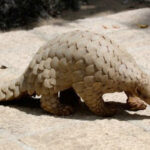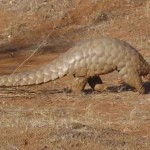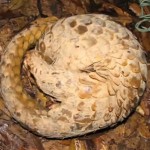A review of the status of Cambodia’s endangered Sunda pangolins.

The endangered Sunda pangolin is the only species of scaly anteater found in Cambodia, but alarming declines in their numbers have conservationists, scientists, and wildlife managers questioning just how much longer this nation will have any to call her own.
They are the most valuable wild animals in the Cambodian market and their dwindling numbers are increasing their worth in the illegal wildlife trade, creating the perfect recipe for fast extinction.
The nation’s pangolin populations have been so severely overexploited that poachers now struggle to find them in the bush.
Here we review the national status of these imperiled creatures, based on reports made by experts at the 2008 Workshop on Trade and Conservation of Pangolins Native to South and Southeast Asia.
Historical use of pangolins in Cambodia
Local use of pangolins and their body parts is steeped in superstition, similar to that in China and Vietnam – the world’s leaders in pangolin consumption.
In Cambodia, they have historically been harvested for local folk medicines, health tonics, and as a source of protein.
There, both adults and fetuses are used in many of the same ways they are used in China and Vietnam.
Blood, scales, and fetuses are used to make cure-all remedies, which consumers mistakenly believe can cure a wide variety of ailments – even cancer.
Much like tiger bone wine, pangolin “health tonics” are made by mixing the animals’ blood with wine or even soaking whole carcasses in vats of the alcohol.
Their keratinous scales are also worn as amulets to ward off bad spirits, stuffed pangolins are sold as souvenirs, and their skin is used for leather fashion accessories, like cowboy boots and handbags.
Cambodia’s pangolins now targeted for illegal export, not local consumption
Although there has long been some local demand for pangolins in Cambodia, they are now rarely targeted for local markets.
Rather, they are being illegally exported mainly to China and Vietnam, where a voracious appetite for these defenseless creatures is driving rampant poaching throughout Cambodia (and beyond).
As the market price for pangolins is high, they are now only rarely used for food and medicine in rural areas…Most pangolins are exported to Viet Nam and China…However, the Cambodia-Viet Nam trade in pangolins has received little attention and little is known about source areas and border crossings.
This shift is a common trend throughout the geographic distributions of all four Asian pangolin species and coincides with the booming economic growth of consumer nations’ affluent middle class.
Traders pay locals to hunt the pangolins and to smuggle them out of the country, and many middlemen are involved in the process of getting the animals to end markets.
Between 2001 and 2008, at least 558 pangolins were seized by Cambodian authorities; however, this represents only a small fraction of the number that were actually entering the trade from or through this country.
Despite sufficient protective legislation, Cambodia’s pangolin numbers continue to fall
There are actually at least eight different laws or parts of laws in place that can protect Cambodia’s increasingly rare pangolins, but sadly, their populations continue to plummet.
Article 49 of the national Forestry Law states that it is illegal to “harass, harm, hunt, net, trap, poison, possess, stock, maintain as a zoo or pet, transport, trade, export, or import” pangolins within Cambodian borders and violators face one to five years in prison, a fine of up to about US $2,390, or both.
Cambodia’s Convention on International Trade in Endangered Species (CITES) Management Authority and the Ministry of Agriculture, Forestry, and Fisheries (MAFF) claim successful implementation of existing legislation is challenged by a lack of coordination between enforcement agencies.
Only certain government agencies can enforce the applicable laws and unfortunately, this seems to result in many cases falling through the cracks.
Lack of biological and ecological information also hampers conservation efforts
Very little is known about the biology and ecology of pangolins and only one field study has ever been conducted on the Sunda pangolin.
In fact, there are no reliable population estimates for Cambodia’s scaly anteaters, nor for Sunda pangolins elsewhere in Southeast Asia.
Much of what we know about pangolins is anecdotal and sadly, a lot of it comes from the hunters themselves.
The lack of information about these animals is a major hurdle for conservation efforts and the sooner these gaps in knowledge are filled, the sooner wildlife managers can make better decisions and create improved action plans that can also bolster law enforcement.
Dry season is death season for Cambodia’s pangolins
In Cambodia, hunting pressure on pangolin populations is most intense during the dry season, which falls between October and May each year.
During this time, pangolins tend to stay close to water sources, which helps hunters identify areas where the animals are more likely to be.
Additionally, the forests are more accessible to poachers without the heavy rains, and lulls in rice farming during the dry season allow them more time for hunting.
It seems Cambodia’s pangolins would benefit greatly from increased patrols and scaled up law enforcement activity during these peak months.
Poachers use nylon snares and dogs to capture their prey
Although hunting methods vary by region, nylon snares are the most commonly used technique for capturing the scaly anteaters in Cambodia.
They are typically set in long lines of up to 100 snares and are sometimes strategically placed near a pangolin found resting in a tree or burrow.
The poachers also use dogs to track down both pangolins and tortoises in the bush.
NGOs offer a ray of hope
Non-governmental organizations (NGOs), Wildlife Alliance and Conservation International, have been at the frontline in Cambodia, fighting to save the last of nation’s pangolins.
Wildlife Alliance (WA) has been central to rescuing pangolins confiscated from the trade through the deployment of their Wildlife Rapid Rescue Team (WRRT) and their alliance with Phnom Tamao Wildlife Rescue Center (PTWRC), a rehabilitation facility for sick and injured animals.
Because scaly anteaters do not fare well in captivity, it is imperative that live individuals be returned to the wild as soon as possible.
Over the last few years, Conservation International-Cambodia (CI) has been monitoring successfully released individuals, in order to assess their survival rates and post-release behaviors.
Information gained from this research can help identify the most successful methods for release and provides invaluable insight into pangolin biology and ecology that can help improve management and action plans for these animals.
CI has also been collaborating with the National Cancer Research Institute and the US National Institute of Health to collect DNA samples from Cambodia’s pangolins, which will supply critical information to law enforcement agencies that may help improve conviction rates.
Both CI and WA are members of the Pangolin Conservation Support Initiative, a body developed to support the efforts of stakeholders in pangolin conservation throughout Southeast Asia.
The work of NGOs like CI and WA are critical to ensuring the future of these insectivorous creatures and they need all the support they can get.
Author: Sarah Pappin. Read more about Sarah here.
Source: Sandrine Pantel and Chin Sing Yun (ed.). 2009. Proceedings of the Workshop on Trade and Conservation of
Pangolins Native to South and Southeast Asia, 30 June-2 July 2008, Singapore Zoo, Singapore. TRAFFIC Southeast Asia, Petaling Jaya, Selangor, Malaysia
Image: Joxerra Aihartza (Nire argazki-bilduma / own picture) via Wikimedia Commons




![Indonesia: Pangolin Smugglers Doing Their Dirty Work [Photos]](http://pangolins.org/wp-content/uploads/2015/08/WorldPangolinDay2013-01-copy-150x150.jpg)

Comments are closed.